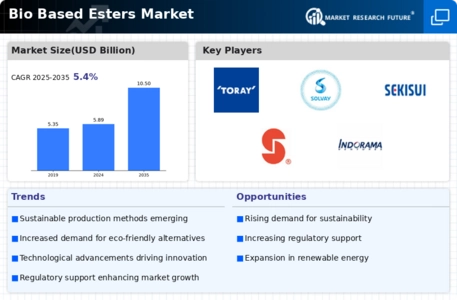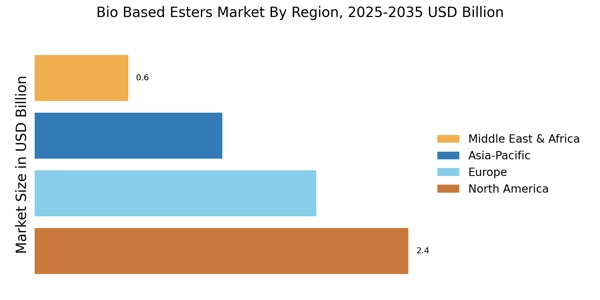Regulatory Support
Regulatory support plays a crucial role in propelling the Bio Based Esters Market forward. Governments worldwide are implementing stringent regulations aimed at reducing carbon emissions and promoting the use of renewable resources. Policies that incentivize the production and use of bio based materials are becoming more prevalent, creating a favorable environment for the bio based esters market. For instance, various countries have established mandates for biofuels, which often include bio based esters as a key component. This regulatory framework not only encourages manufacturers to invest in bio based esters but also fosters consumer acceptance. As a result, the market is expected to witness robust growth, with estimates suggesting a potential increase in market size by 10% annually over the next five years.
Technological Innovations
Technological innovations are significantly influencing the Bio Based Esters Market. Advances in production techniques and processing technologies are enhancing the efficiency and cost-effectiveness of bio based ester manufacturing. Innovations such as enzymatic synthesis and improved catalytic processes are enabling the production of high-quality esters from renewable feedstocks. These advancements not only reduce production costs but also improve the overall sustainability of the manufacturing process. As a result, the market is experiencing a shift towards more efficient production methods, which could lead to a projected market growth of 7% annually through 2025. The integration of technology in the bio based esters sector is likely to attract new investments and drive competition among manufacturers.
Sustainability Initiatives
The increasing emphasis on sustainability initiatives is a pivotal driver for the Bio Based Esters Market. As consumers and businesses alike become more environmentally conscious, the demand for sustainable products has surged. Bio based esters, derived from renewable resources, offer a viable alternative to petroleum-based products, aligning with the global shift towards greener solutions. In 2025, the market for bio based esters is projected to reach approximately USD 5 billion, reflecting a compound annual growth rate of around 8%. This growth is indicative of the rising preference for eco-friendly materials across various sectors, including automotive, cosmetics, and food packaging. Companies are increasingly investing in bio based esters to enhance their sustainability profiles, thereby driving innovation and market expansion.
Consumer Awareness and Preferences
Consumer awareness and preferences are increasingly shaping the Bio Based Esters Market. As individuals become more informed about the environmental impacts of their choices, there is a noticeable shift towards products that are perceived as sustainable and eco-friendly. This trend is particularly evident in sectors such as personal care, food, and packaging, where consumers are actively seeking out bio based alternatives. Market Research Future indicates that approximately 60% of consumers are willing to pay a premium for products made from renewable resources, which is driving manufacturers to incorporate bio based esters into their offerings. This heightened consumer demand is expected to propel market growth, with projections suggesting an annual increase of 9% in the bio based esters market over the next few years.
Rising Demand in Automotive Sector
The automotive sector's rising demand for bio based esters is a significant driver for the Bio Based Esters Market. As automakers increasingly seek to reduce their carbon footprints, bio based esters are being utilized in various applications, including lubricants, fuels, and plasticizers. The shift towards electric vehicles and hybrid models is also contributing to the demand for bio based materials, as manufacturers aim to create more sustainable vehicle components. In 2025, it is anticipated that the automotive industry will account for nearly 30% of the total bio based esters market, reflecting a growing trend towards eco-friendly alternatives. This demand is likely to stimulate further research and development in bio based ester applications, fostering innovation within the industry.


















Leave a Comment